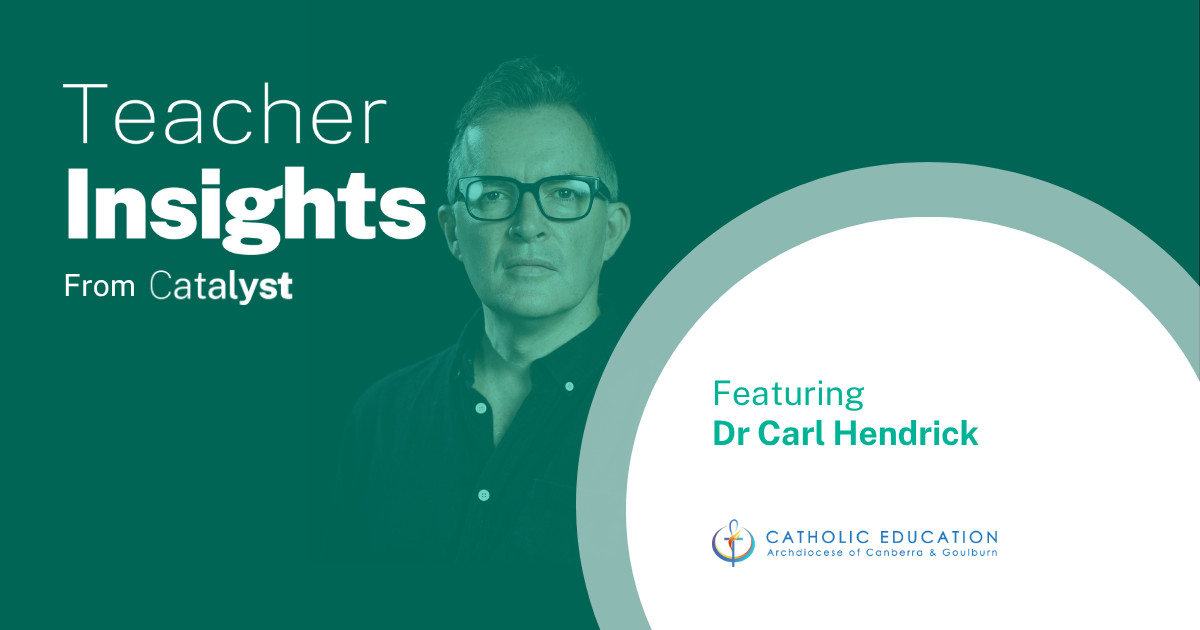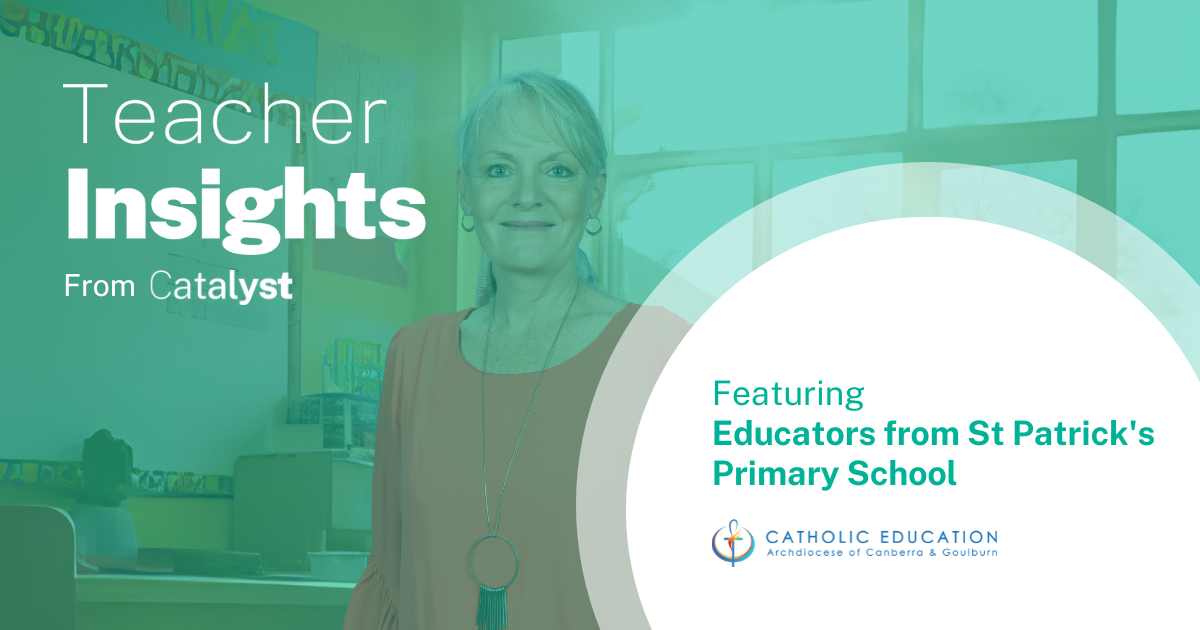
Frequently Asked
Questions
FAQs
Answers to your most commonly asked questions
-
What is Catalyst?
Catalyst ensures every student in every classroom has access to high-quality instruction from teachers who deliver engaging and impactful lessons.
Catalyst provides a consistent approach to teaching and learning across our Archdiocese, making the movement for teachers and students between schools seamless.
This teaching and learning approach is based on the best available research on how students learn, retain and retrieve information.
Learn more about our Teaching Approach
Learn more about CatalystWhy do we need Catalyst?Catalyst ensures every student in every classroom has access to high-quality instruction from teachers who deliver engaging and impactful lessons.
Catalyst provides a consistent approach to teaching and learning across our Archdiocese, making the movement for teachers and students between schools seamless.
This teaching and learning approach is based on the best available research on how students learn, retain and retrieve information.
How does Catalyst align with the CECG vision?Catalyst aligns to the CECG strategic plan Faith in Learning through our committment to supporting our teachers in their vocation to enrich students’ lives through learning. Catalyst aligns to CECG vision of “Jesus Christ, our greatest teacher, calls us to share and bear witness to our Catholic Faith and Tradition, build inclusive communities and deliver contemporary quality learning opportunities for every person.”
Catalyst does this by supporting our teachers, Leaders, and Principals to transform students’ lives through learning ensuring excellence and equity in education
Where can I learn more about the foundation research that underpins Catalyst?Catalyst is backed by a comprehensive body of knowledge and research on how students learn to read, known as the Science of Reading and the Science of Learning.
Explore our Teaching Approach
Learn more about the Science of Learning by checking out the resources available in the Catalyst Knowledge Packs –
Knowledge Pack 1.0
Knowledge Pack 2.0
Knowledge Pack 3.0How will Catalyst improve Teaching and Learning outcomes?Catalyst is based on the best available research on how students learn, retain and retrieve information.
Leveraging this research ensures our approach and the implementation it in our classrooms is the most effective and efficient way possible for student learning.
Where can I find out more about working with CECG and Catalyst?With 56 schools and 9 early learning centres across ACT & NSW we’re working to support the development of excellent principals, leadership teams and teachers in schools across the Archdiocese, through the Catalyst program.
-
What is our Literacy approach?
Our teaching approach for Literacy is backed by a comprehensive body of knowledge and research on how students learn to read, known as the Science of Reading.
The Science of Reading refers to a body of evidence that encompasses multi-disciplinary knowledge from education, linguistics, cognitive psychology, special education and neuroscience. It is centred on improving Literacy outcomes for all students and will help us to achieve our bold goal “every student is a competent reader”.
What is a “competent reader”?At CECG, we believe reading is a key enabler for learning – when students can read well, they build their capacity to learn and build greater knowledge.
The aim of learning to read is comprehension, or the capacity to extract meaning from print. Reading comprehension is largely the function of two broad skill sets, identified in the Simple View of Reading.According to the Simple View of Reading, reading comprehension is the combination of using both decoding and language comprehension skills. A student becomes competent at reading when they can use both of these skills to read and understand texts appropriate to their year level. This is true of every student across all year levels.
What does reading competency mean for K-2 students?Early Years Literacy development is critical to future learning. K-2 classrooms across CECG schools prioritise the implementation of evidence-based literacy programs. What is taught focuses on the 6 components of Reading (Phonemic Awareness, Phonics, Fluency, Vocabulary, Comprehension and Oral Language). These programs incorporate a Systematic Synthetic Phonics approach in structured lessons, which has been proven to drive positive student reading outcomes.
What is Systematic Synthetic Phonics?Systematic Synthetic Phonics is an evidence-based, structured and explicit approach to teaching students how to read. The instructional principles align with the scientific evidence of the cogntiive processes involved in learning to read.This method of reading helps children to learn the relationships between the sounds (phonemes) of spoken language and the letter symbols (graphemes) of the written language.How do we monitor student progress in reading?The Dynamic Indicators of Basic Early Literacy Skills (DIBELS) assessment tool is used across all primary classes to screen, monitor and precisely understand what students know and can do, and where further support is required in Reading. Through the introduction of the DIBELS assessment tool and other reading based assessments, we can access more reliable data to inform our baseline level of reading across year levels.
Explore all the ways we track and report on the impact of Catalyst
What is the Science of Reading?The Science of Reading refers to a body of evidence that encompasses multi-disciplinary knowledge from education, linguistics, cognitive psychology, special education and neuroscience. The Science of Reading looks at the essential cognitive processes for competent reading and describes how reading develops in both typical and atypical readers. These studies have revealed a great deal about how we learn to read, what goes wrong when students don’t learn, and the instructional strategies that facilitate the cognitive processes required for reading.
What is High Impact Teaching Practice?High Impact Teaching Practice (HITP) equips teachers with the foundational theory and practical understanding to implement evidence-based pedagogy in their classrooms. Centred on Rosenshine’s Principles of Instruction, HITP focuses on the most effective and efficient way to teach.
Is HITP aligned to Rosenshine’s Principles of Instruction?Yes, the foundation of High Impact Teaching Practice (HITP) is based on Rosenshine’s Principles of Instruction.
-
How have we measured success so far?
Our ability to measure outcomes, impact and showcase the benefits of the Catalyst program for our teachers and students has been critical through the implementation to ensure success. As such, CECG engaged Deloitte Access Economics (DAE) as an external, objective evaluator to monitor and evaluate the program during the initial implementation period.
What is used to determine/assess what makes our students competent readers?In 2021, we first introduced the Dynamic Indicators of Basic Early Literacy Skills 8th Edition (DIBELS) to monitor the development of early literacy and early reading skills in K-2. With additional reading based assessments, we can access more reliable data to inform our baseline level of reading across year levels and inform our teaching practices to support students’ individual learning needs.
In the coming years, we will continue to use these assessment models to track improvement in reading outcomes.
Learn more about the Impact of Catalyst -
How are leaders supported to implement Catalyst in their school?
Leaders are supported to gain the knowledge and expertise they need to implement Catalyst in their school through professional learning, networking and mentoring opportunities.
Leaders are empowered to plan and implement their schools Catalyst journey to ensure they get maximum impact within their context.
To ensure all schools can implement Catalyst effectively, CECG’s Teaching & Learning Team and Performance and Improvement Leaders work with each school individually to determine a suitable implementation plan and timeline.
How does Catalyst support Curriculum resourcing?Catalyst supports curriculum resourcing and assessment across the system by curating selected high-quality resources that align to the Australian Curriculum and NSW Syllabus.
Curriculum resources have been developed to support in areas of English and mathematics, with more learning areas across primary and secondary to be explored. These resources have been made available to CECG schools within the school’s Catalyst Team.
Literacy Curriculum supports and resources are also available for schools including The Writing Revolution, Spelling Mastery, MiniLit and MacqLit. For more information on these resources please speak with the Teaching and Learning team.
How do teachers integrate Direct Instruction, Explicit Instruction and Inquiry learning in their lessons?Catalyst provides professional learning in evidence-based pedagogy through High Impact Teaching Practice (HITP) and Literacy.
Catalyst prioritises an Explicit and Direct Instruction approach as the most effective and efficient way to teach students, who in most cases are novice learners. Students across our schools have opportunity to inquire, explore and create but we work towards doing this from a place of knowledge. It isn’t about one or the other, but it is about Explicit and Direct Instruction before Inquiry.
Teachers are empowered to deliver High Impact Teaching Practice into their lessons for all students and to respond accordingly thereafter based on student response and needs.
What does Catalyst mean for a classroom teacher?Catalyst provides them with professional learning and coaching opportunities.
All teachers in the Archdiocese engage in components of Catalyst professional learning and develop an understanding of how to implement High Impact Teaching Practice (HITP) in their classrooms.
Each school will have a different implementation timeline and journey. For more information on your school’s journey, speak with your Principal or Leadership Team.
What curriculum areas is Catalyst prioritising?Catalyst connects with all curriculum areas with a priority focus on literacy and numeracy across all year levels.
Research has shown the importance high-quality of early learning to future academic success. Our literacy focus for the early years (K-2) will provide all students with the foundational skills for future learning.
Further, a review of CE’s performance in 2020, found that student outcomes could be improved in mathematics, across all year levels. Through Catalyst, a suite of high-quality curriculum resources for K-10 Maths is in development.
How does Catalyst work in a secondary school setting?High Impact Teaching Practice is designed for all grades and learning areas. HITP empowers teachers to embed Science of Learning in their classrooms, no matter the year level or subject they are teaching.
CECG are committed to developing high quality curriculum resources for secondary teachers, with Years 7-10 Maths in development and other curriculum areas to follow.
How are support staff involved in the Catalyst journey?Classroom Support Assistants (CSAs) are engaged in whole school Catalyst professional learning and trained in MiniLit and Macqlit intervention programs.
-
How do I implement this in my classroom?
Teachers will be provided with the knowledge and resources to implement the HITP in their classrooms. These are provided through formal professional learning sessions, focusing on theory, demonstration, practice and feedback, along with online units and coaching.
Which aspects of HITP are being addressed? Can we choose which ones we do or are they a complete set?HITP provides a complete set of practices based on Rosenshine’s Principles of Instruction. Teachers and leaders are provided with professional learning, supports and resources to understand each principle or practice and the important interdependencies associated.
Do we need to complete the Catalyst Online Units in a specific order, or can we change the order based on our school needs?The online units have been designed to be taken in a specific order, however revisiting the units or specific aspects is encouraged
When will teachers have time for the modules/training?Most of the professional learning will be completed during allocated professional development time. The theory aspect of Catalyst will not require extra time from teachers – we are simply shifting our professional learning focus to incorporate the Catalyst program.
Teachers will complete HITP in Action training in school hours through coaching days or through a master class model. There may be some preparation or filming of lessons required for coaching purposes which can be worked into existing time at school.
Each school will have a different implementation timeline and journey. For more information on your school’s journey, speak with your Principal or Leadership Team.
How do we ensure we cater for all needs when implementing an Explicit Instruction approach?Catalyst will help CECG schools to implement a comprehensive teaching and learning approach. All teachers will learn about evidence-based practice aligned with the Science of Learning, and apply a range of pedagogical techniques to cater for all learners. Catalyst focuses on first wave teaching, what is the best approach for the majority of learners. Support and guidance is then provided for teachers to respond accordingly to student needs through scaffolding or additional supports along with formal Tier 2 and Tier 3 intervention structures.
What resources will we be provided?Teachers will have access to online units, professional learning and curriculum resources via the Catalyst MS teams Resource Hub.
For more information on the resources available for your school, speak with your Principal or Leadership Team.
What does Catalyst mean for a classroom teacher?Catalyst provides them with professional learning and coaching opportunities.
All teachers in the Archdiocese engage in components of Catalyst professional learning and develop an understanding how to implement High Impact Teaching Practice (HITP) in their classrooms.
Each school will have a different implementation timeline and journey. For more information on your school’s journey, speak with your Principal or Leadership Team.
How does Catalyst support curriculum resourcing?Catalyst supports curriculum resourcing and assessment across the system by curating selected high-quality resources and manipulatives that align to the Australian Curriculum and NSW Syllabus.
Curriculum resources have been developed to support K-10 Mathematics, 3-6 English, with more learning areas across K-12 to be explored. These resources have been made available to schools in the Curriculum Hub, available in your school’s Catalyst Team.
Literacy curriculum support is also available for schools with programs including The Writing Revolution, Spelling Mastery, MiniLit and Reading Tutor Program. For more information on these resources please speak with your Principal or Leadership Team.
Is the professional learning undertaken through Catalyst eligble accreditated hours?Yes, most of the professional learning undertaken through Catalyst is eligible to be claimed as TQI accredited hours and used for maintenance of NESA hours
How are support staff involved in the Catalyst journey?Classroom Support Assistants (CSAs) are engaged in whole school Catalyst professional learning and trained in MiniLit and Macqlit intervention programs.
What curriculum areas is Catalyst prioritising?Catalyst connects with all curriculum areas with a priority focus on literacy and numeracy across all year levels.
Research has shown the importance high-quality of early learning to future academic success. Our literacy focus for the early years (K-2) will provide all students with the foundational skills for future learning.
Further, a review of CE’s performance in 2020, found that student outcomes could be improved in mathematics, across all year levels. Through Catalyst, a suite of high-quality curriculum resources for K-10 maths is in development.
How does Catalyst work in a secondary school setting?High Impact Teaching Practice is designed for all grades and learning areas. HITP empowers teachers to embed Science of Learning in their classrooms, no matter the year level or subject they are teaching.
CECG are committed to developing high quality curriculum resources for secondary teachers, with Years 7-10 Maths in development and other curriculum areas to follow.
-
What does Catalyst mean for my child/children?
Catalyst ensures every student in every classroom across the Archdiocese has access to teachers who deliver high-quality engaging and impactful lessons.
Catalyst provides a consistent approach to teaching and learning across our Archdiocese, making the movement between classes and schools seamless.
How will Catalyst improve teaching and learning outcomes for my child?The Catalyst approach is based on the best available research on how best students learn.
Leveraging this research ensures our approach is the most effective and efficient possible to maximise learning opportunities for students.
A key focus of Catalyst is on early literacy. Research has shown the importance high-quality of early learning to future academic success. Our literacy focus for the early years (K-2) will provide all students with the foundational skills for future learning.
How can I support my child at home?Parents are encouraged to discuss how they can best support their child’s learning at home with their teacher. Some ways parents may support teaching could include
- Encourage daily reading with your child and support them to explain what they learnt or enjoyed in the book. For younger children, ask them to read aloud to you.
- Encourage your child to talk about a topic, idea or skill they have learnt at school, on a daily basis.
- Ask your child’s teacher for specific support and advice for reading together at home.
Where am I learn more about the foundational research that underpins Catalyst?Informed by the Science of Learning and Science of Reading, Catalyst will develop excellent principals, leadership teams and teachers in all Catholic Education Archdiocese of Canberra & Goulburn (CECG) schools through evidence-based professional learning programs.
How will Catalyst improve Teaching and Learning outcomes?Catalyst is based on the best available research on how students learn, retain and retrieve information.
Leveraging this research ensures our approach and the implementation it in our classrooms is the most effective and efficient way possible for student learning.
Why does my school have professional learning days for teachers?To ensure our teachers are kept up to date with the latest in teaching and learning, schools across the Archdiocese will hold professional development days throughout the year.
These professional development days enable our leaders and teachers to engage in system-wide professional learning to determine how they will use the collective knowledge and provided resources, effectively in the classroom.
CONTACT US
Still have questions?
Whether it’s feedback, a question or concern, we would love to hear from you. Send us your message below and we will be in touch.

Related Resources
You might also like


S3|E4: Transforming Teaching Through Catalyst with St Patrick’s Primary School
